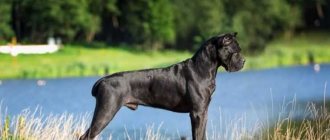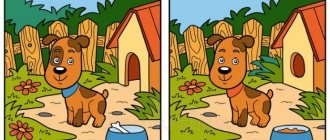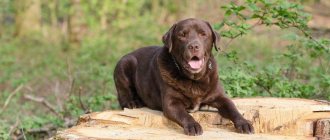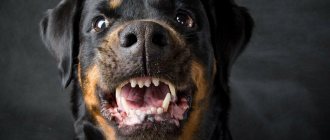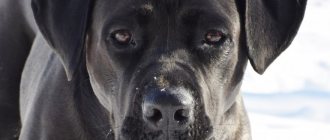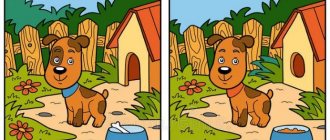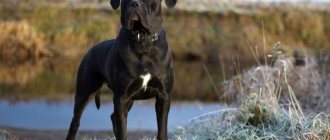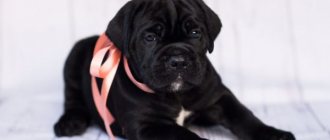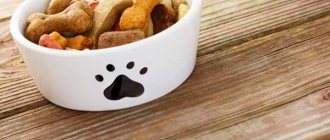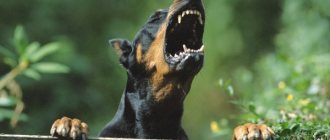History of the breed
The breed descended from dogs of the Molosser group - one of the oldest on earth. The ancestors of the Cane Corso were gladiator dogs, baiting dogs, and guard dogs.
The name of the breed comes from cane - a derivative of the Latin canis (dog), corso - from cortos (yard, corral).
Cane Corso are fighting dogs, they went on military campaigns, dressed in special armor, and took part in battles with the heavy cavalry of the enemy. However, their first specialty is livestock protection. And during campaigns with Roman legionaries, they “earned extra money” as guards of herds. What herds? The fact is that there were no canned food in those days, but after a hard day a soldier wants to eat. So they drove along with the famous legions herds of large-horned “live meat”.
Security
With the collapse of the Roman Empire, dogs found use in agriculture, where strong muscles and powerful jaws always have a job.
In the Middle Ages, interest in powerful handsome men was revived. They were loved by hunters and... people of creative professions - artists and sculptors. Of course, such beauty is not captured in stone or on canvas.
The first studies of the ancestors of the Italian Cane Corso were carried out back in 1540 by the Italian thinker, writer, and historian Teofilo Folengo.
The Middle Ages passed, so did the interest in the Canna Corso, and dogs (remember the name - yard dog) began to work again on farms in the provinces.
The first Cane Corsos were not black; they were striped, with large white stripes. In the process of creating the breed, the blood of bullmastiffs and boxers was infused into the dogs.
The Second World War greatly reduced the number of almost all dogs. Cane Corsos were no exception.
Until recently, the breed in its historical homeland was on the verge of extinction, when it began to be restored (in the 70s of the last century). Giovanni Nizolli took on this hard work. In all of Italy there were about 60 Cane Corsos. Almost all of them were distinguished by viciousness and aggression towards humans. This was due to the fact that they were used as guard dogs in small farms.
A group of enthusiasts managed to revive the breed and gain international recognition.
Since then, magnificent dogs with a terrifying appearance and a gentle soul have become the pride of Italy.
How to extend a dog's life
As soon as you think about purchasing a dog, you first need to study the literature about the breed, its characteristics, rules of keeping and upbringing.
Vaccination
One of the main measures to prevent acquired diseases is vaccination. The puppy must receive its first vaccination from the breeder. They begin to do them from the age of one month.
Then 2 more vaccinations every 4 weeks. Revaccination is done at six months and a year. Each manipulation is recorded in the animal’s veterinary passport.
Only healthy dogs can be vaccinated. Bacteria and microbes cause deadly diseases. The virus can be transmitted on shoes and clothes. Therefore, no matter how good the home conditions for the puppy are, you should not neglect vaccinations.
Important! You can take the puppy outside only after the third vaccination.
Precautionary measures
Regardless of the Cane Corso's age and vaccination status, it is not advisable to allow him to come into contact with stray or wild animals. This is fraught with infection by viruses and bacteria, which are sometimes incurable. You can't pick up food from the ground, it happens that it is poisoned.
Playing with wild rodents can result in a bite, which often kills dogs.
Regardless of age and vaccinations, the dog should not be allowed to come into contact with stray and wild animals.
Proper nutrition
The Cane Corso can only be compared in size to a horse, so they eat quite a lot. Protein should predominate in the diet. If you feed dry food, then premium class is preferable. If it is natural food, then most of it is meat and offal.
Pork, tubular bones, river fish, sour cream, sweets, smoked meats, pearl barley and millet porridge should under no circumstances be included in the diet of Corsos.
Vitamin supplements with a high calcium content are as necessary for such large dogs as air.
Hygiene
Cane Corsos do not require much grooming. A standard set of hygiene rules, like all dogs:
- ear cleaning;
- washing paws after a walk;
- bathing no more than 3 times a year;
- combing wool;
The problem with the breed is excessive salivation. Keep napkins or towels on hand.
Description and breed standard
The Cane Corso dog breed belongs to the Molosser group according to the FCI classification.
Breed standard
These are strong animals with powerful muscles, with a peculiar brutal elegance.
The Cane Corso must have:
- Large, typical Molosser head.
- The nose is black, large, with wide nostrils; if there is a gray mask on the muzzle, the color of the earlobe is acceptable to match the mask.
- Powerful jaws, underbite.
- The eyes are oval, slightly convex, widely spaced. The darker the iris, the better.
- The ears are set high, triangular, hanging, of medium size.
- The length of the neck is equal to the length of the head, muscular, powerful.
- The length of the body is slightly greater than the height at the withers.
- The tail is set quite high, very thick at the base, not curled.
- The metacarpus of the front paws are “cat-like”; The pasterns of the hind legs are not so collected.
- Thick skin that fits well to the body.
- The dog's fur (fur) is short, very dense, shiny, the undercoat is seasonal.
| Height in cm | Weight in kg | |
| Males | 64-68 | 45-50 |
| Bitches | 60-64 | 40-45 |
Various colors
The coat color is varied, it can be:
- black;
- lead gray;
- light gray;
- light and dark fawn;
- red fawn;
- brindle (stripes of different shades of fawn or gray).
Healthy childhood and puppy care
Taking care of your dog's well-being begins with following all the rules for caring for your puppy. And, since we are talking about the life expectancy of a pet, we will talk about vaccinations. An infection from which the Cane Corso is not protected can cause serious complications and even lead to death.
The first comprehensive vaccination, for example with Eurican or Duramun, is usually given by the breeder himself when the baby is 6 weeks old. The second is done at 8 weeks, the third at 12. Then the dog is vaccinated at the age of six months and a year, and then revaccinated annually, including against rabies. All procedures must be performed by a veterinarian, noting vaccinations in the animal’s veterinary passport.
An unvaccinated Cane Corso cannot be taken outside for walks, since from 1.5 to 3 months its immunity is still actively developing, and the body is susceptible to infections. Remember that only healthy dogs can be vaccinated. Two weeks before going to the doctor, you need to give her water to treat worms.
Vaccination is a must even for pets who live in an apartment, because bacteria, viruses and helminth eggs travel well on your shoes, clothes and other things.
Even if you give your Cane Corso vaccinations on time, this does not cancel other basic rules. Do not allow your pet to come into contact with stray animals. You can catch such things from them that it doesn’t seem like much. Make sure that when walking, your dog does not climb in the trash, walk through garbage dumps, or pick up scraps from the ground. The area designated for your Cane Corso in your home should always be clean and dry.
Watch your diet carefully. If after eating your dog develops lethargy, diarrhea, vomiting, or begins to itch very much, most likely the food is not suitable for him, it is better to change it. Many dog breeders advise feeding Cane Corso only with natural food, and not with store-bought food.
But this is a matter of choice, because a dog can be allergic to any product. Pay attention to which foods in the diet go well and which ones cause discomfort in your Cane Corso. If you ignore your pet's food problems, over time they will lead to disastrous results.
Breed characteristics and character traits
Cane Corso dogs have a powerful body and a gentle heart. Powerful Italians are monogamous - for them the world collapses if the owner leaves.
The character of the Cane Corso is the embodiment of self-confidence, calmness and enormous inner strength. One of the main features of dogs of this breed is a clear division of those around them into “us” and “strangers”. Cane Corsos exist to guard and protect their own from any danger. At home they are quite soft and affectionate and can take on the role of a nanny.
For the Cane Corso, family always comes first. From the owner to the baby blowing bubbles in the cradle. The territory, the house, the living creatures, and any utensils belonging to the family are sacred to the pet. And let only someone dare to encroach on family and property. Although, for sure, there will be no takers.
Italians will not show aggression towards those to whom the owner is friendly. If the owner is not on the territory, excuse me, the Cane Corso is a guard. And I simply have to detain you. If he doesn’t eat it, say thank you.
Dogs are not prone to wandering; a territory that they consider under their control is enough for them.
Life expectancy and stages of growing up of a Cane Corso
The average lifespan of a Cane Corso is 10–12 years:
- A representative of this breed can be considered an adult at 3 years old.
- Then the period of active life lasts up to 6 years.
- After this period, the dog begins to age, and at 8 years old it can already be considered a veteran.
Cane Corsos take a long time to mature, but age quickly
How long old age will last and how much quality of life awaits the dog throughout this period largely depends on the care of the pet, which was carried out from birth, and the characteristics of its old age.
The oldest Cane Corso lived in Italy and died at the age of 14. But this is an out of the ordinary case. Only a few live up to 12 years. The bulk of the Cane Corso leaves this world at the age of 9–11 years.
Video: interesting facts about the Cane Corso breed
Care and maintenance
Italians with their short hair are not adapted to kennel keeping, because in winter they simply freeze, and in summer also because they need close communication with their family.
Faithful friends
Care does not take much time. Brushing during shedding, cleaning ears, trimming nails is not at all difficult. If necessary, wipe your eyes with a cotton pad. The disc is moistened with boiled water, freshly brewed tea, and chamomile infusion.
It is not advisable to bathe your Cane Corso often; 3-4 times a year is enough. But when you come from the street in inclement weather, you will have to wipe your paws and belly with a damp towel.
Do not forget about timely vaccination of your dog; A couple of weeks before vaccinations, it is necessary to deworm your pet.
If you want to feed your pet dry food, choose at least premium food. Don’t be too lazy to prepare natural food for your pet - be sure to include vitamins and mineral complexes in the diet.
The dog should have 2 bowls in a certain place: one for food, the second for water. The water should be fresh, it is better to change it 2-3 times a day.
Pets absolutely need quality walking, with active physical activity. Walks should take at least one and a half to two hours a day.
Cane Corsos love to hang out with family members and become happy puppies when playing.
There are a couple of unpleasant aspects to the content of cors:
- drooling (like any dog with jowls);
- Their fur is “spiky.”
We deal with drool simply - we buy bibs; Wipe the dog 2-3 times a week with a damp towel. With “thorns” it’s even easier - there is such a thing as a vacuum cleaner.
Factors that affect the lifespan of a Cane Corso
There are a number of factors that influence the lifespan of a Cane Corso. A person purchasing a puppy of this breed must know in advance about its weak points. If you violate the rules of caring for your pet from childhood, you may later encounter many pathologies that will greatly shorten the dog’s life.
Heredity
There are a number of Cane Corso diseases that are hereditary. Representatives of the breed are prone to these pathologies, and under unfavorable circumstances for the dog, such diseases are likely to manifest themselves. These include:
- Hip dysplasia. This pathology is the scourge of almost all large breeds. If the articular head is incorrectly positioned in the bed, the cartilage layer wears out, and the dog begins to experience severe pain when walking or statically supporting its paws. Over time, the situation only gets worse, which can lead to complete immobilization of the animal. But if you pay attention in time to lameness and the dog’s efforts to protect its paw from stress, then surgery can improve the situation.
- Eversion or inversion of the eyelid. The disease leads to damage to the cornea of the eye, which can lead to its loss. But usually the owners notice in time that the pet’s eyelid is in an unusual position (turned outward or turned inward). The situation is corrected surgically, but sometimes there are cases of relapse.
- Epilepsy is a chronic disease of the nervous system, which is manifested by a dog’s tendency to have seizures. The attack may result in the dog losing consciousness. After the first episode of epilepsy, the dog is examined and prescribed medications to prevent recurrence of the seizure. In principle, with regular treatment and caring care, a dog can live to its full allotted time.
- Thyroid diseases. These pathologies can manifest as a whole range of symptoms: from dry skin and dull coat to severe weakness. The effectiveness of treatment depends on how early the owners began to sound the alarm. Therapy can be drug or surgical, depending on the specific type of organ pathology.
Professional, conscientious breeders do not allow breeding of individuals that have developed one of these diseases, so that the new generation does not inherit the “sick” gene. But those who breed the breed for profit not only do not pay attention to this, but also carefully hide the presence of this problem in the family from potential buyers. Such people also take advantage of the fact that many pathologies appear in dogs only over time, in adulthood or old age.
Cane Corsos are prone to certain genetic pathologies
A pedigree can serve as a kind of guarantee that the risk of pathologies in a given pet is not so great. It contains notes about the 4 previous generations of dogs. If there were sick individuals in the family, this information must be entered into the document. Even puppies are tested for hip dysplasia. The breeder cannot refuse you to carry it out - this will lead to the idea of deception.
Timely vaccination
Not all diseases are purely hereditary. A pet can find many infections when interacting with other dogs, not necessarily close ones, for example, when exercising on the same sports ground. Therefore, all dog owners are advised to ensure that their pet is vaccinated.
Usually the first vaccination is given by the breeder at the age of 6 weeks. The second vaccination is given at 8, and the third at 12 weeks. After this, the dog is vaccinated at 6 months and at 1 year. Then you should go for vaccinations once a year.
If you bought an unvaccinated dog, the veterinarian will develop an individual vaccination schedule for the pet.
Unvaccinated Cane Corsos should not be taken outside at all. Their body is very susceptible to infections. It is better to administer the vaccine at a veterinary clinic rather than on your own. 2 weeks before vaccination, the dog is wormed and treated for other parasites (for example, fleas, if any).
Timely vaccination is a prerequisite for participation in exhibitions
Even if your Cane Corso is fully vaccinated, do not allow him to come into contact with stray animals, and do not allow him to dig through garbage or pick up anything from the ground outside.
Usually, puppies are given a general obedience course to prevent the dog from acting independently, regardless of the owner’s orders.
Proper care and maintenance
Your pet should have its own place in the house - clean and dry. The bedding is washed at least once a month (this often needs to be done more often).
To prevent improper formation of joints, a dog up to 6 months of age is carried down steps by hand (she can climb them herself).
Particular attention should be paid to feeding. If a natural nutrition plan is chosen, the diet should be developed with your veterinarian to include all the nutrients your pet needs. Usually in this case, the veterinarian will also prescribe vitamin and mineral complexes.
When choosing industrial food, preference should be given to high-quality super premium or holistic class products. They mostly consist of high quality meat ingredients and contain a balanced composition of vitamins and minerals.
It is important to monitor the weight of your Cane Corso. Excess of it has an adverse effect on the joints. Ideal breed weight:
- females - 40–45 kg;
- males - 45–50 kg.
Cane Corso has a tendency to allergies, so new dry food is given with caution, observing the condition of the pet’s coat and skin. If the body reacts strongly, the dog may begin to itch, the skin will peel, and the coat will lose its shine.
Physical exercise
The Cane Corso needs exercise. Walking should be done twice a day for at least 2 hours. Regular exercise on a leash is not enough for your pet; he needs to run. It would be better if it were activities on the sports ground or accompanying the owner riding a bicycle.
Daily exercise is mandatory for the Cane Corso.
The breed is recommended for people leading a fairly active lifestyle.
Does the gender of a dog affect life expectancy?
There is no big difference between the life expectancy of boys and girls Cane Corso. Girls are simply calmer and more flexible (they are recommended for families with children), boys are more strong-willed and active (the owner needs to match such a strong character).
But castration or sterilization can prolong the life of a pet, or rather, protect it from premature death. If you do not plan to have offspring from your dog, it is better to take it for this simple operation. This will reduce the risk of genital cancer in old age.
Cane Corsos can be wary of strangers, but with members of their own family they are usually affectionate and loyal. The owners note that as their pet gets older, they begin to understand each other at a glance. It's worth it to extend your friend's life as much as possible.
Education and training
The Italian Cane Corso dog breed looks delightful on the sofa or rug in front of the fireplace. But this is not their purpose. For these dogs, the main thing is Family. For her, a Cane Corso will give their life, not to mention such a trivial matter as protecting a family member from an aggressor or an old bucket from a thief. Corsicas learn these jobs easily, genetic memory helps. But the pet must be raised and trained “from a young age”
A pet must be trained from infancy
A very important aspect of training is the development of working qualities.
These are games where the dog learns the commands “fetch”, “give”, “come to me”.
Such a serious dog as a Cane Corso must know and follow the commands:
- to me;
- give;
- near;
- sit;
- stand;
- it is forbidden.
You can learn the rest of the commands or not as you wish. But in any case, it will be better if the pet’s time and brain are occupied with training, work, and play. Dogs left to their own devices get bored, become depressed, and start acting up.
Diseases that Cane Corsos are susceptible to
How long can Cane Corso live and what diseases are they prone to? These are the most common questions that owners ask breeders and veterinarians when they take a puppy of this breed into their home. Some diseases can appear at an early age, others are inherited. Therefore, it is very important to find out from breeders what the dog’s ancestors suffered from.
Cane Corso are prone to diseases such as:
- articular dysplasia (usually manifests at an early age);
- thyroid diseases;
- epilepsy (hereditary disease);
- diseases of the gastrointestinal tract;
- eversion and inversion of the eyelid;
- allergies of various kinds:
In addition to the above ailments, do not forget about viral problems, parasites and infections. Particular attention should be paid to the prevention of tick bites, which the breed does not tolerate well.
It is worth noting that joint dysplasia cannot be cured. Therefore, until the dog is 2 years old, you should refrain from walking on stairs and not overuse running and jumping.
Important! For early diagnosis of diseases and their consequences, Cane Corso dogs are recommended to be examined by specialists every six months.
Until the dog turns 2 years old, you should refrain from walking on stairs and jumping.
How much does a dog cost and how to choose a puppy?
There are not very many nurseries in Russia, which is why the prices for Cane Corso puppies are quite high. But don’t rush to grab the first available puppy; first get to know the kennel and breeders, and the puppy’s parents. Find out if mom and dad have awards and diplomas. Puppies of “foreign” parents will be more expensive.
Puppy
Not all the requirements of the standard will appear at one and a half months, when puppies are usually sold. Therefore, study the standard and look with an “enlightened gaze” at mom and dad.
The puppy itself should be cheerful and cheerful. The fur is shiny, smooth, the ears are clean, the eyes are clear - this is how a puppy should be.
A puppy “for the home”, without the prospect of breeding, will cost 15-25 thousand rubles. Breeding and show class puppies are allowed for breeding. Their prices are much higher. The price minimum is 35 thousand rubles, the upper limit is limited only by the amount that a potential buyer is willing to pay.
Dog problems in old age
Old age is not a joy for anyone, and animals are no exception. After 7-8 years, the life of a Cane Corso begins to decline, which is reflected in both physical form and behavior. In good conditions, dogs of this breed can remain active until death. But you shouldn’t demand from the “grandfather” the same agility as from a one-year-old dog.
Many Cane Corso owners say that in old age these dogs become especially noble, impressive and even wise. The elderly “Italian” is phlegmatic, he already knows everything about life and condescendingly watches the pampering of the little puppies.
However, “veteran” Cane Corsos may exhibit disturbances in gait, balance, attention, and slower reactions. As some dog breeders put it, the dog “stumbles out of the blue.” Heart problems are also common in older dogs - poor myocardial contractility, arrhythmia. They are treated with special medications under the supervision of a veterinarian.
Males of the Cane Corso breed can develop prostatitis with all the accompanying inconveniences - inflammation, problems with the toilet. In addition, by the time of “retirement” all old injuries make themselves felt - sprains, fractures, dislocations. Therefore, even a young Cane Corso should be spared and not overloaded during walks, and comply with safety requirements.
Quite often, Cane Corso owners ask whether gray hair is normal in dogs. As a rule, there is nothing wrong with it. Even two- to three-year-old animals had gray hairs on their faces, but this is not a sign of early aging.
If a dog has gray hair when he was young, then the reason is heredity, not illness. Sometimes this may indicate a hormonal imbalance in the body.
